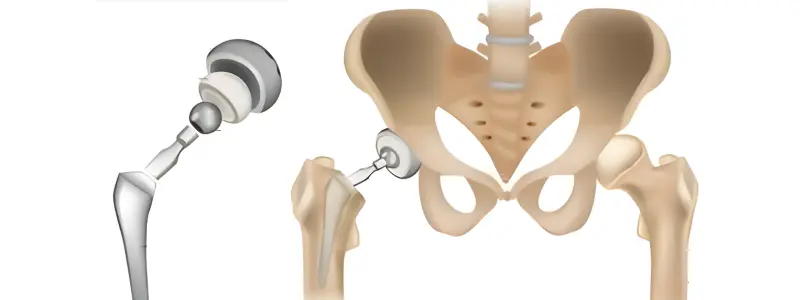PMG Hospital is best orthopedic hospital in Ahmedabad for knee replacement, hip replacement, Trauma surgeries & Arthroscopy treatments

Hip Replacement or arthroplasty surgeries are performed to restore the functionalities and stability of joints by removing and replacing bone fragments with artificial implants or prostheses.
Revisional Hip Replacement is replacing old prosthetic or artificial implants with other prosthetics using specialized tools and techniques for better and long-lasting results.
Revisional Hip Replacements are different and more complex than primary Hip Replacements as they require specialized implants, planning, and orthopedic surgical expertise.
A candidate for total hip replacement is typically someone who experiences severe hip pain and stiffness that limits daily activities and doesn’t respond to other treatments such as medications, physical therapy, or injections. Common conditions that might lead to this surgery include osteoarthritis, rheumatoid arthritis, avascular necrosis, hip fracture, or other forms of degenerative joint disease. Candidates for total hip replacement often have significant joint damage that affects their quality of life and mobility. The decision to undergo surgery is made in consultation with an orthopedic surgeon based on factors such as the severity of symptoms, overall health, and the patient’s ability to participate in post-operative rehabilitation.
Total hip replacement surgery involves removing the damaged parts of the hip joint, including the femoral head (the ball) and the acetabulum (the socket), and replacing them with artificial components. The procedure typically includes the following steps:
Preparation and Anesthesia: The patient is given anesthesia, either general (putting the patient to sleep) or regional (numbing the lower body).
Incision: The surgeon makes an incision on the side or back of the hip to access the joint.
Resection: The damaged femoral head is removed and replaced with a metal stem that is inserted into the femur (thigh bone). The acetabulum is prepared by removing damaged cartilage and reshaping the socket to accommodate the artificial cup component.
Implantation: The metal stem with a metal or ceramic ball attached to the end is inserted into the femur. A plastic, ceramic, or metal cup component is inserted into the acetabulum to replace the socket.
Closure: The surgeon closes the incision with sutures or staples and covers it with a sterile bandage.
Recovery: The patient is taken to a recovery area for monitoring. Post-surgery, the patient begins a rehabilitation program, including physical therapy, to regain strength and mobility in the hip.
The main difference between total hip replacement (THR) and partial hip replacement (PHR) lies in the extent of the joint replacement and the components used:
Total Hip Replacement (THR):
Partial Hip Replacement (PHR):
The choice between total and partial hip replacement depends on factors such as the extent of damage to the hip joint, the patient’s age, activity level, and overall health. An orthopedic surgeon will evaluate these factors and recommend the most appropriate procedure for the individual patient.
The cost of total hip replacement can vary widely depending on several factors, including the country and region where the surgery is performed, the specific hospital or surgical center, the surgeon’s fees, the type of implant used, and any additional medical expenses.This estimate usually includes the surgeon’s fee, hospital stay, anesthesia, pre-surgery consultations, and post-surgery physical therapy. Insurance coverage can significantly affect the out-of-pocket cost for patients, so it’s important to check with your insurance provider for specific details regarding coverage and potential expenses.
The types of implants for total hip replacement (THR) vary based on the materials used, the design, and the fixation method. Here are the main types:
Yes, both hips can be replaced at the same time in a procedure known as bilateral hip replacement. However, this approach is less common than replacing one hip at a time due to several considerations:
Surgical Complexity: Bilateral hip replacement is a more complex surgery that typically requires a longer operating time and may increase the risk of complications such as blood loss, infection, and thrombosis.
Recovery Challenges: Recovering from bilateral hip replacement can be more challenging compared to single hip replacement. Patients may experience difficulty with mobility, rehabilitation, and daily activities during the initial recovery period.
Medical Fitness: Not all patients are suitable candidates for bilateral hip replacement. Factors such as age, overall health, fitness level, and the extent of hip damage must be carefully evaluated to determine the appropriateness of simultaneous surgery.
Staged Approach: In many cases, hip replacements are performed sequentially, with the surgeries spaced several months apart. This staged approach allows for easier rehabilitation and recovery between surgeries.
The lifespan of a hip replacement can vary depending on various factors, including the patient’s age, activity level, the type of implant used, and the underlying condition being treated. On average, a hip replacement can last between 15 to 20 years or more. Advances in surgical techniques and implant materials have improved the longevity of hip replacements, and many patients experience functional and pain-free use of their artificial hip for two decades or longer. However, factors such as excessive wear, implant loosening, or bone loss over time may necessitate revision surgery to replace or repair the implant. Regular follow-up with an orthopedic surgeon and adherence to post-operative care and rehabilitation guidelines can help maximize the lifespan of a hip replacement.
Our Services

Total Hip Replacement Surgeon in Ahmedabad, Gujarat
Putting the patient first is the only philosophy we believe in at PMG Hospital. Practicing knee replacement surgeries for more than one decade we always tried to prescribe the most effective and essential surgeries like partial knee replacement over total knee replacement if it is the only required as per the patient’s medical conditions.
PMG Hospital is best orthopedic hospital in Ahmedabad for knee replacement, hip replacement, Trauma surgeries & Arthroscopy treatments